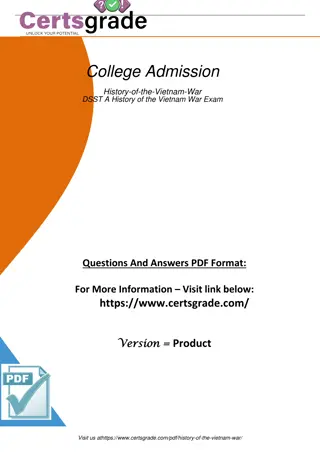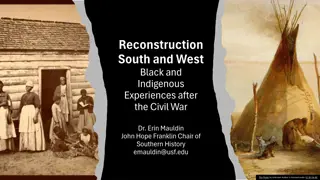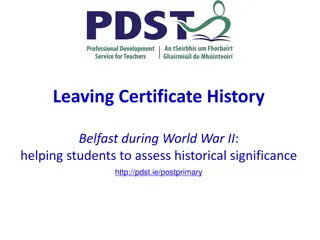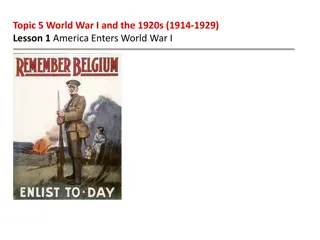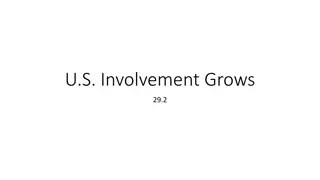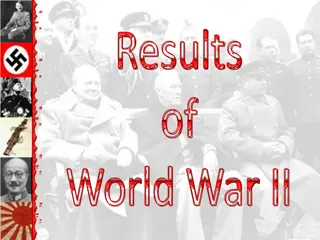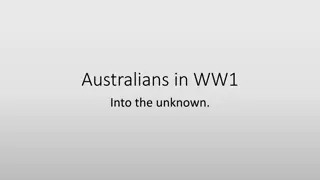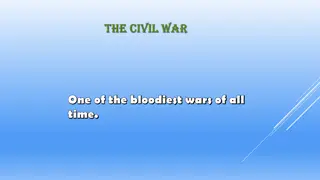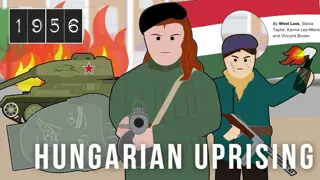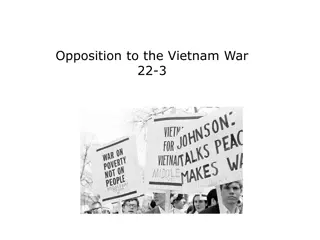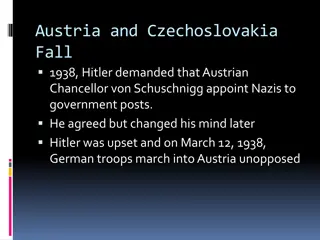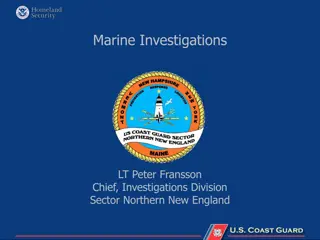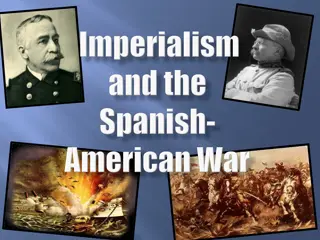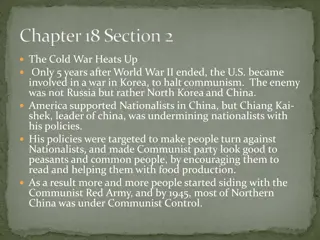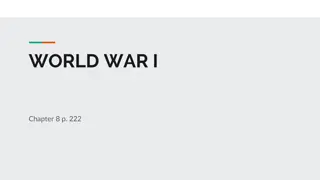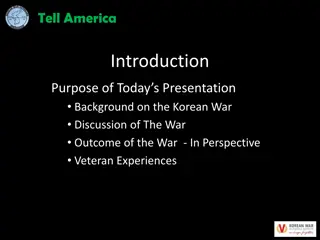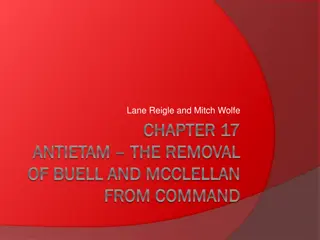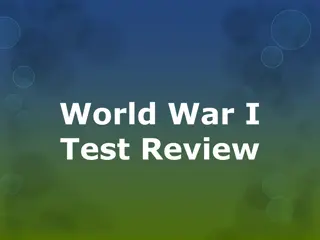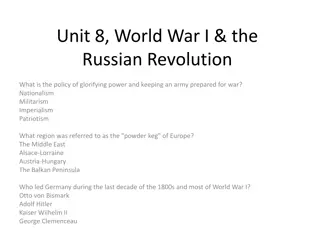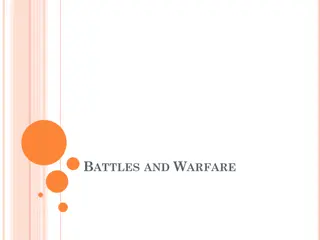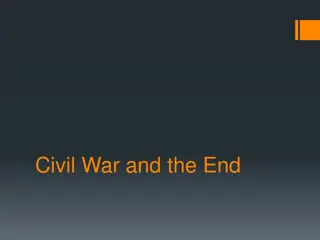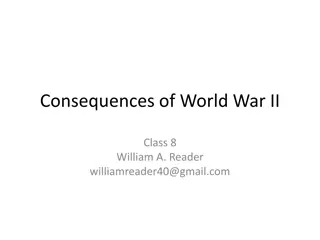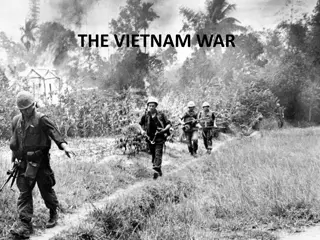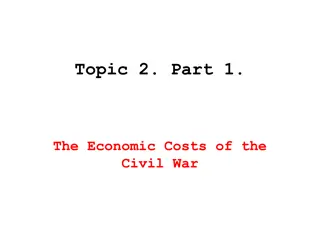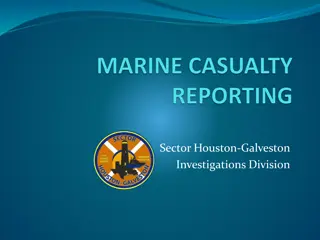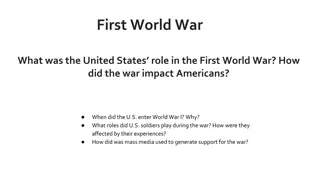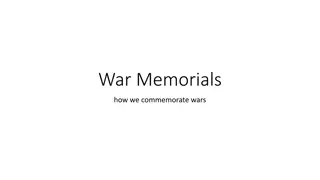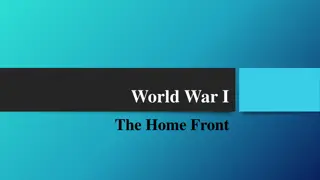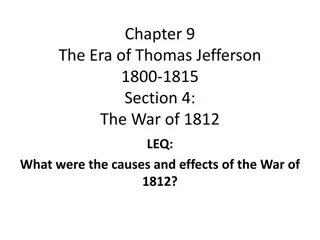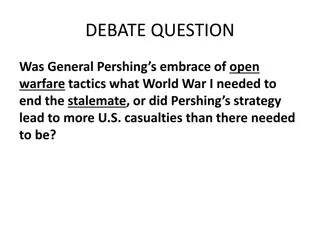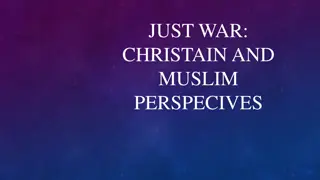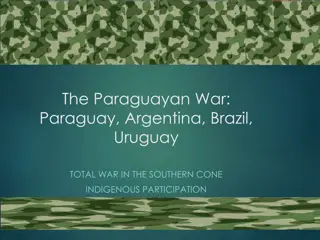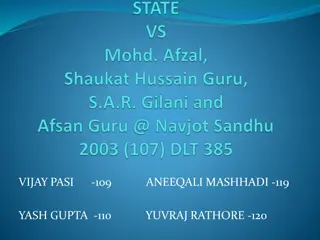❤[PDF]⚡ Civil War Talks: Further Reminiscences of George S. Bernard and His Fel
\"COPY LINK HERE ; https:\/\/getpdf.readbooks.link\/0813931754\n\nRead ebook [PDF] Civil War Talks: Further Reminiscences of George S. Bernard and His Fellow Veterans (A Nation Divided: Studies in the Civil War Era) | Civil War Talks: Further Reminiscences of George S. Bernard and His Fellow Vetera
1 views • 6 slides
Dominate the DSST A History of the Vietnam War Exam
Arm yourself with comprehensive study materials and expert guidance to conquer the DSST A History of the Vietnam War Exam. Unlock success with practice tests, study guides, and proven strategies. Start your journey to victory today!\nClick Here to Get History-of-the-Vietnam-War Dumps With 16 USD Dis
1 views • 6 slides
Post-Civil War Experiences in the South and West
Explore the intertwined experiences of Black and Indigenous communities in the aftermath of the Civil War, shedding light on the challenges and conflicts faced in the South and West regions. Delve into the complexities of Reconstruction, the impact of the Civil War on Indigenous peoples, and the pre
1 views • 24 slides
Exploring Historical Significance of Belfast During World War II
Assisting students in assessing the historical significance of Belfast during World War II through an enquiry-focused approach. The content covers key aspects such as the impact of World War II on Belfast, its strategic importance, political leadership, the Belfast Blitz of 1941, and key terms relat
0 views • 32 slides
America's Entry into World War I: Causes and Impacts
World War I and the 1920s witnessed America's transition from neutrality to active involvement in the war. Factors such as nationalism, militarism, imperialism, and alliances led to the conflict. The impact of technological innovations resulted in stalemate on the Western Front, leading to significa
0 views • 11 slides
The Homefront: U.S. War Production Efforts During World War II
During World War II, the United States mobilized its industries for total war production, converting peacetime factories into facilities for producing planes, tanks, rifles, and more. The U.S. became the Allies' biggest armaments supplier, producing millions of war supplies and significantly boostin
2 views • 25 slides
The Americanization of the Vietnam War: Escalation and Challenges
In February 1965, President Johnson escalated U.S. involvement in the Vietnam War through Operation Rolling Thunder, intensifying bombing campaigns and increasing troop commitments. This shift in strategy, driven by American assumptions and General Westmoreland's counsel, aimed to Americanize the wa
0 views • 12 slides
World War II Casualties and Costs Overview
This collection of images and data provides a comprehensive overview of World War II casualties and costs, detailing the devastating impact of the war on various countries in Europe, Asia, and beyond. From military casualties to civilian losses and financial costs, the information sheds light on the
0 views • 6 slides
Australians in WW1: Into the Unknown
In June 1914, the assassination of Archduke Franz Ferdinand triggered a chain of events leading to World War I. Australia, as part of the British Empire, declared support for the war effort. Despite the distance from the theatres of war, over 300,000 Australians enlisted, with significant casualties
0 views • 22 slides
Origins of the Cold War: Yalta and Potsdam Conferences 1945
The Cold War's origins stem from the tensions and suspicions between the USSR and the West post-World War II, highlighted through conferences like Yalta and Potsdam. At the Yalta Conference, held in February 1945, crucial decisions were made regarding Germany, Poland, and the UN. The Potsdam Confere
0 views • 10 slides
Insights into World War Two and Adolf Hitler's Role
World War Two started on September 3, 1939, with Britain and France declaring war on Germany. Adolf Hitler's rise to power, initiation of the war, and involvement in the Holocaust are highlighted. The Star of David symbolized Jewish identity under Hitler's rule, and the Holocaust saw six million Eur
0 views • 6 slides
The Civil War: Key Facts and Insights
The Civil War, one of the bloodiest conflicts in history, was fought from April 1861 to Spring 1865. Triggered by the divergence on slavery between the Northern and Southern states, over 22 million people were involved, resulting in over 650,000 casualties. Learn about the war's origins, major battl
0 views • 16 slides
Hungarian Revolution of 1956: Impact on the Cold War
The Hungarian Revolution of 1956 marked a significant episode in the Cold War era, challenging Soviet dominance and leading to widespread consequences. The uprising, led by Imre Nagy, faced brutal Soviet suppression, resulting in thousands of casualties and reinforcing Soviet control over Hungary. T
0 views • 10 slides
Analysis of W.B. Yeats' Poetry During World War I
W.B. Yeats' poetry during World War I reflects a unique perspective on the conflict, as seen in works like "An Irish Airman Foresees His Death" and "On Being Asked for a War Poem." Delving into themes of sacrifice, duty, and the futility of war, Yeats offers a contrasting view to the graphic realism
0 views • 7 slides
Opposition to the Vietnam War: A Closer Look
The Vietnam War sparked significant opposition, with key factors including the draft policy, disproportionate African American involvement, and student activism. The credibility gap between the government and the public worsened as casualties mounted. Resistance to the war led to policy changes, suc
0 views • 15 slides
Timeline of Key Events Leading to World War II
In the years leading up to World War II, a series of significant events unfolded in Europe. From Hitler's demands and annexations to the signing of pacts and the invasion of Poland, tensions escalated rapidly. The Munich Agreement, German offensive in Poland, declaration of war by France and Britain
0 views • 12 slides
Important Guidelines for Reporting Marine Casualties
Learn about the NVIC 01-15 regulations for immediate reporting of hazardous conditions and marine casualties to the Coast Guard. Understand the responsibility of notifying the Command Center in case of incidents, reporting injuries involving passengers and crew, and the criteria for serious marine i
0 views • 21 slides
The Impact of the Korean War on Global Relations
The Korean War, often dubbed the "Forgotten War," had significant implications on global politics and relationships. This conflict was characterized by a mix of conventional and guerilla warfare tactics. China's involvement in the war had a profound impact on its relations with the U.S. and the U.S.
0 views • 14 slides
The Spanish-American War: Origins and Impact
The Spanish-American War was fueled by a combination of factors including economic struggles, imperial ambitions, and sensationalist journalism. Theodore Roosevelt's stance on war, coupled with the desire for Cuba's independence from Spain, led to a call for war in the late 1890s. Yellow journalism
0 views • 18 slides
The Cold War Heats Up: Korea and China Conflict
The post-World War II era saw the U.S. engaging in the Korean War to combat communism, facing off against North Korea and China instead of Russia. Conflict in China between the Nationalists led by Chiang Kai-shek and the Communists under Mao Tse-tung intensified, with Chiang's authoritarian rule spa
0 views • 14 slides
Causes and Outbreak of World War I
Various factors such as nationalism, imperialism, militarism, and the assassination of Archduke Francis Ferdinand led to the outbreak of World War I. The tensions in Europe escalated as countries formed alliances and mobilized for war. The conflict resulted in early battles like the Battle of Marne
0 views • 23 slides
Overview of the Korean War: Background, Discussion, and Outcome
This presentation delves into the background of the Korean War, highlighting the historical context from the Korean Peninsula's division after World War II to the outbreak of the conflict in 1950. It discusses the involvement of North and South Korea, as well as key players like the United States, t
0 views • 15 slides
The Battle of Antietam: Removal of Buell and McClellan from Command
The Battle of Antietam, also known as the Battle of Sharpsburg, had significant casualties with more killed or wounded in one day than in multiple previous wars. The battle involved key areas such as The Cornfield, The Woods, The Sunken Road, and Rohrbach Bridge. It ended as a tactical draw but a st
0 views • 18 slides
World War I Test Review and Historical Overview
Learn about the key terms and concepts related to World War I, including militarism, nationalism, neutrality, propaganda, espionage, and more. Explore the long-term causes of the war, the immediate trigger, the Central Powers and Allied Powers involved, as well as important events like the Zimmerman
0 views • 13 slides
World War I and the Treaty of Versailles: Key Events and Consequences
The policy of glorifying power and militarism, the tensions in the Balkan Peninsula, Germany's leadership, causes of the United States' entry into World War I, impact of unrestricted submarine warfare, transition to total war, the end of the war with an armistice, the Treaty of Versailles assigning
0 views • 10 slides
Women's Roles in Warfare During the World Wars
Women played significant roles in warfare during the World Wars, serving as nurses, taking on essential jobs, and even disguising themselves to join combat. Despite restrictions, women like Maria Bochkareva in Russia and the Women's Battalion of Death made valuable contributions, leading to broader
0 views • 23 slides
Major Battles and End of the Civil War Timeline
The timeline covers significant events during the American Civil War, including the Battle of Shiloh, Second Battle of Bull Run, Battle of Antietam, Gettysburg, and the Gettysburg Address. The battles were consequential, resulting in high casualties and strategic shifts in the war. The Gettysburg Ad
0 views • 17 slides
The Impact of World War II on Japan and the Emergence of the Cold War
World War II had far-reaching consequences on Japan, leading to significant naval battles, intense fighting in Okinawa, and ultimately, the country's surrender following the atomic bombings of Hiroshima and Nagasaki. The post-war period saw the emergence of the Cold War as tensions rose between the
0 views • 63 slides
The Vietnam War: Facts, Background, and US Involvement
The Vietnam War, spanning from 1955 to 1975, was a devastating conflict resulting in thousands of casualties, making it the longest war in US history. The war originated from Vietnam's complex history as a French colony, strategic US involvement due to containment policies and the domino theory, and
0 views • 13 slides
The Economic Costs of the Civil War and Its Impact on Growth
The Civil War led to significant economic costs for both the North and the South, including direct expenses such as government spending, destruction of physical and human capital, and indirect costs due to reduced consumption. The war resulted in massive casualties and had a profound impact on the e
0 views • 34 slides
Reporting Requirements for Marine Casualties in Sector Houston-Galveston Investigations Division
Sector Houston-Galveston Investigations Division outlines the reporting procedures for marine casualties including when to report, reportable casualties, serious marine incidents, required chemical testing, and reporting forms. Reporting must be done promptly and accurately to ensure safety and comp
0 views • 11 slides
The United States in World War I: Impact, Soldiers' Experiences, and Media Support
The United States played a significant role in World War I, entering the war in 1917 and sending soldiers to fight in Europe. The war impacted Americans socially and economically. U.S. soldiers served in various roles and were affected by their experiences. Mass media was used to generate support fo
0 views • 15 slides
Honoring Sacrifice: War Memorials Across the Globe
Explore a visual journey through various war memorials such as the Boer War Memorial in Belfast, the Menin Gate in Ypres, the Cenotaph in London, the Tomb of the Unknown Warrior in Westminster Abbey, the Korean War Veterans Memorial in Washington DC, the Vietnam Veterans Memorial Wall in Washington
0 views • 9 slides
America's Role on the Home Front during World War I
During World War I, America witnessed significant changes on the home front as the government took on new powers to regulate industry, agriculture, and public opinion. Women and minorities played crucial roles, voluntary rationing was embraced, and opposition by conscientious objectors was met with
0 views • 24 slides
The War of 1812: Causes, Events, and Effects
The War of 1812 was influenced by issues such as British impressment of American sailors, arming Native Americans, and trade restrictions. Despite opposition, President James Madison declared war in 1812. The conflict marked a period of American nationalism, with War Hawks pushing for war and Doves
0 views • 16 slides
General Pershing's Strategy in World War I: Ending the Stalemate or Increasing Casualties?
General Pershing's embrace of open warfare tactics in World War I sparked a debate on whether his strategy was the key to breaking the stalemate or if it led to unnecessary U.S. casualties. His preference for hand-to-hand combat over trench warfare raised questions about the effectiveness of traditi
0 views • 4 slides
Perspectives on Just War Theory from Christian and Muslim Standpoints
Just War Theory, rooted in Christian philosophy, aims to justify the use of force in specific circumstances to defend justice and protect human life. While pacifists reject all forms of war, adherents of the theory believe in certain criteria that must be met for a war to be considered just, such as
0 views • 16 slides
The Paraguayan War: Total Conflict in the Southern Cone
The Paraguayan War, also known as the War of the Triple Alliance, involved Paraguay, Argentina, Brazil, and Uruguay in a brutal conflict from 1864 to 1870. President Carlos Antonio López's policies and the ambitions of Francisco Solano López led to Paraguay's defiance of its neighbors, resulting i
0 views • 10 slides
Economic and Financial Development of Croatia During and After the War
Experience and lessons from the Croatian War of Independence, including impacts on economic growth, banking sector reforms, inflation control, and monetary policy framework. The war, lasting from 1991 to 1995, resulted in significant casualties, territorial losses, and economic damages, with Croatia
0 views • 34 slides
Terrorist Attack on Indian Parliament: Trial and Convictions
An incident on 13th December 2001 where the Indian Parliament was attacked resulted in casualties. Five terrorists were killed, and four accused persons were linked to the conspiracy. Mohd. Afzal Guru and Shaukat Hussain Guru were involved in supplying materials and funds for the attack. Accused Nav
0 views • 11 slides
![❤[PDF]⚡ Civil War Talks: Further Reminiscences of George S. Bernard and His Fel](/thumb/20551/pdf-civil-war-talks-further-reminiscences-of-george-s-bernard-and-his-fel.jpg)
